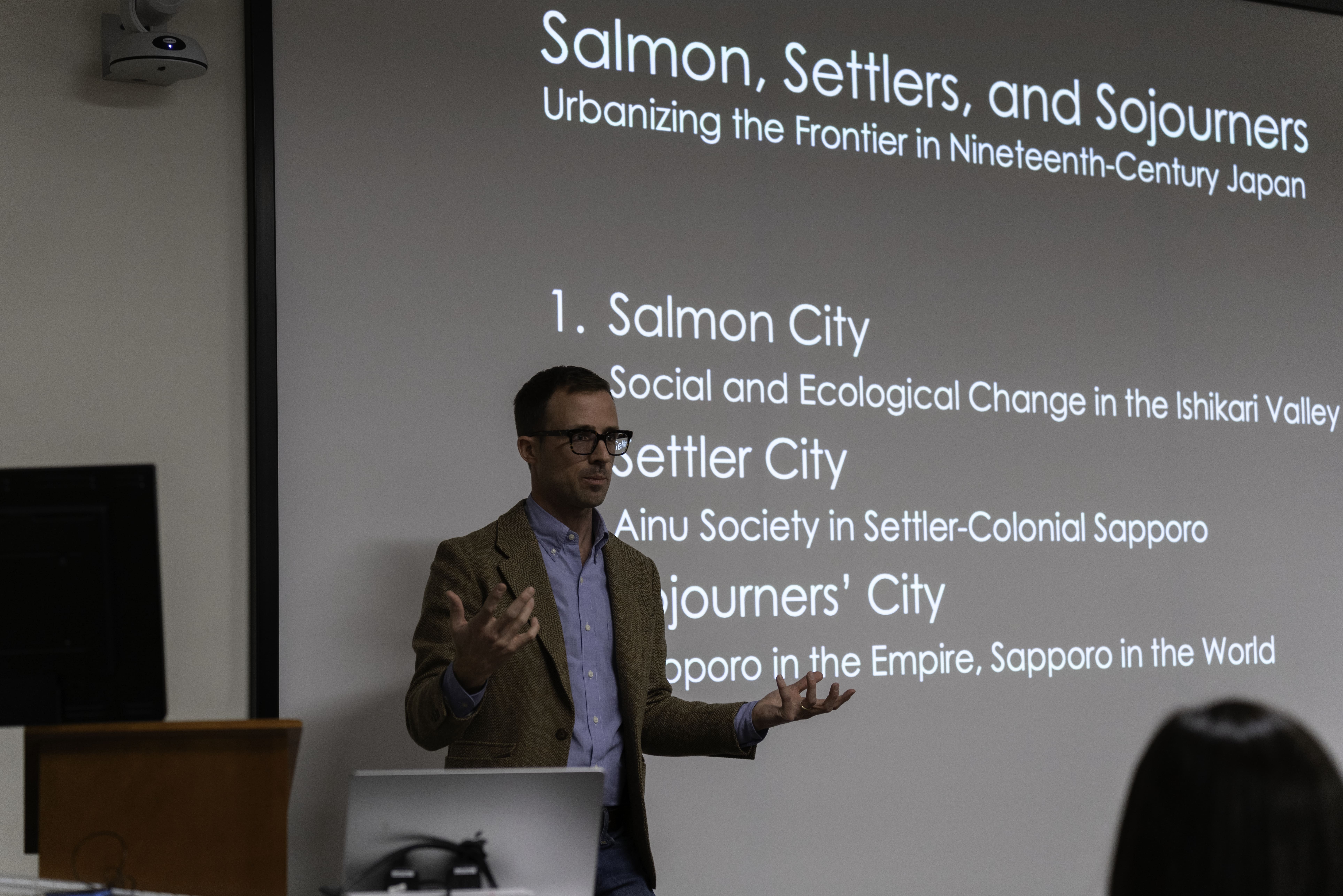Northeastern Professor Michael Thornton’s talk promotes reflection on Japan’s colonial history
February 28, 2025
 Khalil Wilkinson
Khalil WilkinsonTuesday afternoon, Professor Michael Thornton, an assistant teaching history professor at Northeastern University, discussed the urbanization and colonization of the northernmost major island of Japan, Hokkaidō, with a focus on the city of Sapporo and the Ainu Indigenous population.
The talk, titled, “Salmon, Settlers and Sojourners: Urbanizing the Frontier in Nineteenth-Century Sapporo” was split into three distinct elements, each utilizing images and maps of the region to illustrate how it has changed over time. Thornton was brought to campus in part because of his connection to Associate Professor of History and Asian Studies Sakura Christmas. Christmas introduced Thornton at the talk.
“Sakura was a couple years above me in grad school.… She’s also an environmental historian, so I think we’ve been meaning to exchange ideas,” Thornton said.
Thornton said he was inspired to research this topic due to his experience living in Japan.
“I grew up in Japan and always knew I wanted to study Japanese cities and urban planning. I was really interested in this transition from the Tokugawa to the Meiji period,… because Sapporo was founded right at that transition point,” Thornton said in an interview with the Orient. “Most Japanese cities are hundreds, if not thousands of years old, so [it’s exciting that] we actually have all the planning documents from the very beginning.”
At the beginning of the talk, Thornton described the changing social and ecological landscape before Sapporo, specifically looking at the movement of the salmon along local rivers. According to Thornton, the Ainu ran into challenges as the Japanese began to encroach on traditional fishing grounds.
“Over the course of the 18th century, the fishing industry in Hokkaido became increasingly dominated, not by the Ainu themselves, but rather by Japanese commercial operations, which began to undermine and destroy traditional social relations, both within many communities and between the Ainu and the Japanese,” Thornton said.
Thornton described how this increased Japanese commercialization transformed the landscape of Hokkaidō.
“Shrinking salmon catches … reflects the introduction of much more intensive fishing technologies,” Thornton said. “This accompanied the commercialization of the inland salmon industry,… [and] authorities allowed merchants to divide up the river into fishing grounds that they then hired Ainu and Japanese fishers to work,” Thornton said.
Next, Thornton discussed the physical settlement and development of Sapporo as an imperial project during the Meiji restoration, a major transformation during which Japan transitioned from a state run by samurai to a state run by the emperor of Japan, who ruled from Tokyo.
Thornton explained how, under Meiji rule, the state created the Kaitakushi, also known as the Hokkaidō Development Commission. This colonial agency worked to “reclaim” land and encourage Japanese settlement in Hokkaidō, which included the use of violence against the Ainu population.
“They weren’t literally reclaiming land, but they were doing it in territory that until the 1850s had been off limits to Japanese residents, a place that was widely understood as the homeland of the Ainu, who were not considered to be Japanese in any sense of the term, and a region that was only periodically under Japanese political control,” Thornton said. “There have been a number of scholars recently who really criticized this internal colonization that erases the real violence that was visited upon the Indigenous population of Hokkaidō.”
Finally, Thornton described the “sojourners” of Hokkaidō, discussing the transient workers and temporary residents who shaped Sapporo into a colonial city. For example, Thornton highlighted American advisors who introduced Western agricultural techniques, transforming Hokkaidō’s landscape. These colonial innovations, Thornton noted, were later exported to other Japanese imperial projects in Taiwan and Manchuria.
“After 1870, the modernizing impulses of the Meiji state led Hokkaidō’s colonial officials to look for new models of urban and colonial power from other parts of the world. And they looked to the United States,… [hiring] experts in fields such as mining, forestry, horse rearing, agriculture, education [and they] created agricultural testing grounds to adapt Western fruit, apples, strawberries, peaches and so on to Hokkaidō” Thornton said.
Linnea Minich, the research and instruction librarian at Hawthorne-Longfellow Library, attended the talk and said she found the discussion of Hokkaidō highly relevant to settler colonial contexts globally.
“I had no conception of how the Japanese state dealt with Indigenous groups.… I found it really fascinating, the parallels that the speaker drew between settler colonialism in the West and the settler colonialism that was going on here,” Minich said.
The talk also brought out key distinctions between Japanese and other histories. During the Q&A, multiple attendees wrestled with the status of the Ainu people, as Thornton noted that the study of Ainu peoples is difficult, because they have been ethnically intertwined with Japanese for hundreds of years. The Ainu have only remained a distinct group because some Ainu have chosen to outwardly express their heritage, something attendee Asher Savel ’26 highlighted following the talk.
“The Ainu people having to self-report their minority status is widely different from the concept we have of our settler colonialism and the racism we have in our own systems,” Savel said.

Comments
Before submitting a comment, please review our comment policy. Some key points from the policy: